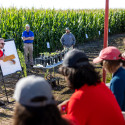New Web site promotes conversation on teaching
Whether they are stumped by a classroom dilemma or inspired by a breakthrough moment with students, faculty and instructional staff will now have the opportunity to spark a broader conversation about teaching practices through a new interactive Web resource.
The Teaching and Learning Excellence (TLE) Web site, which went live near the end of the fall semester, gives faculty and staff a variety of tools to sharpen their teaching skills, find helpful resources or share advice with colleagues.
“The genesis of this project was the recognition that there is lots of great information about teaching and learning on the Web, but no simple way to navigate through all the material,” says Aaron Brower, vice provost for teaching and learning and co-developer of the site. “In addition to creating a portal, we wanted to take advantage of Web 2.0 tools in order to make something that is truly interactive and community-based.”
More than a year in the making, TLE was developed by the Teaching Academy, the Office of the Vice Provost for Teaching and Learning, and the Division of Information Technology’s Academic Technology unit. The group was inspired by some of the community-building tools developed by Blue States Digital to support Barack Obama’s presidential campaign.
Rather than produce another site filled with static links to resources, Brower says the goal is to create a fluid and interactive site that will better serve the interests and creativity of teachers. People are encouraged to add their own links to teaching and learning solutions, favorite resources, articles, blogs and other materials they find useful, and contribute to ongoing conversations on the site. A UW–Madison Net ID and password provides immediate access to the site.
“This type of electronic teaching and learning center offsets the need for a brick-and-mortar office to house information, and it could be a model for other ways to share information and create community,” says Mo Noonan Bischof, assistant vice provost.
A number of faculty and staff have already been using the resource. For example, sociology professor John Delamater posted the commentary “Top 10 Myths About Teaching,” which included “The popular teacher is a bad teacher,” “Students don’t want to work together” and “I don’t need to know my students’ names.” Other recent posts dealt with extracting and using student survey data, using “clicker” technologies in the classroom, and a study on why peer discussion improves learning.
Other resources on the site include:
- A teaching and learning solutions database, developed by the Teaching Academy, which is regularly updated and searchable by student engagement, evaluation and lecturing strategies, among other keywords;
- A discussion forum that includes an open-ended message board, as well as a place to post conference announcements, “knotty problems” in teaching, and awards and grant announcements;
- A conference and workshop calendar that can be populated by anyone with a university net ID;
- A “word cloud” feature that highlights the most frequently referenced topics on the site;
- A section on campus policies that are frequently encountered in the academic setting, such as accommodations for students with disabilities, guidelines for off-campus academic activities and inclement weather policies.
“It was clear from feedback on our old teaching and learning site that users wanted it to feel more like a community; they want resources that are current and can be contributed to,” says Brower. “There was a strong sense that people want to connect across campus, and this Web site helps fill that need.”
Tags: teaching




